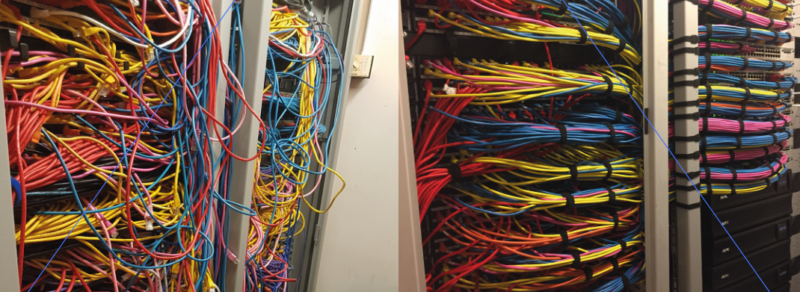Frimley Health Foundation Trust (FHFT) engages Bates Connect to complete its Network Refresh Programme.
Project Background
As an organisation with two legacy domains, split over three major sites, three satellite sites, containing four data centres and over 115 communications rooms with an associated 52728 patches.
Frimley Health Foundation Trust was finding its legacy “End of Life” Network Infrastructure struggling to provide effective performance for its ever growing 12,000 user-base.
Transformation projects including: cloud migration of email services, (VDI) virtual desktop environments and convergence of two legacy (AD) Active Directory environments, required a strong & robust underlying Network Infrastructure.

Frimley Health Foundation Trust engaged Bates Connect Services to complete the “End to End” delivery of the Network Refresh Programme, including:
- Installation of new Cisco edge switches and removal of legacy equipment;
- Recording of legacy switch equipment for CISCO buy back purchasing;
- Re-patch of supported end user devices with new patch leads appropriately colour coded and of suitable length;
- Installation of new UPS units and removal of legacy equipment;
- Recording of legacy UPS equipment for WEEE disposal;
- Early Life Support of Cabinets following upgrades;
- Configuration of edge and UPS devices to remote management tooling;
- Installation of Nexus 2000 fabric expansion units within the defined data centres;
- Re-patch of all supported servers (to Nexus switches) within the data centres;
- Re-Engineer Root Bridge Spanning Tree.
“The Bates Group supplemented our Digital Services Programme on two major projects- a full network upgrade and the migration from two old outlook email exchange servers and consolidation to NSH Mail across two merged Trusts. They also provided some service desk support as we consolidated the two service desks to a one stop service desk for the Trusts.”
Shauna McMahon, Former CIO
Frimley Health NHS Foundation Trust
Technical Background
- Four Dater Centres (split between two sites) – Over 700 Server Connections migrated to FEX.
- 115 Communications Rooms (split between three major & three satellite sites).
- Over 52,000 tag and trace & colour coded patch lead replacements.
- Multiple Mixed Vendors (UPS)
- Uninterrupted Power Supplies Upgrades and Power Drop Connections.
Project Deployment
Bates Connect Resource Deployment
Bates Connect deployed key project management, network design specialists, network deployment engineers, cable install team and auditors. All of which contributed to a successful outcome:
- PRINCE Methodology;
- Reporting included weekly progress statements, monthly RAID report, ad hoc reports (as requested);
- Project involved an initial discovery phase followed by a rapid roll-out period;
- An edge switch replacement pilot exercise was carried out to test the approach;
- A detailed user area audit was carried out. Key users were identified and engaged throughout the project;
- Communications were distributed to all stakeholders prior to commencement of any work;
- This included an initial ‘heads up’ a week or more before intended work, followed by a further communique a day in advance and a printed flyer distributed on the day that work was to be carriedout.
- Network connectivity was maintained for essential systems and users during network upgrades;
- Switch stacks were pre-built (to Cisco best standards specification) and tested prior to deployment;
- Switch stack configurations recorded in an IDF build pack for each cabinet, which included old and new topologies, patching schedules, configurations and much more;
- All new patch leads were ‘dressed off’ and secured as part of the rebuild;
- UPS units were installed in accordance with APC requirements;
- Systems were tested (as far as possible) immediately after upgrade work was completed;
- Floor walkers were on site from early morning the day after upgrade work was carried out to provide early life support;
- An acceptance document was developed for sign off by the Trust and any snagging work identified was documented and addressed.

Project Challenges
Technical Challenge
- Communication Rooms served multiple are-as of an Acute Hospital, therefore extremely detailed planning and communication was required to reduced risk.
- Critical Devices allowed for 2 minutes down-time only, these critical devices were identified & migrated to temporary switches, and had to be managed directly with key stakeholders of the business.
- Downtime windows allowed for 6 hour periods for non-critical devices, in some case up to 14 switches and 672 patches were required.
Business Challenge
- End of Life, Legacy, unstandardized switch models and failing equipment creates poor Network
- Performance for the (FHFT) User base.
- Key infrastructure projects including: cloud migration of email services, VDI and Active
- Directory relied on the dependencies of a Network Refresh Programme.
- Communication Rooms could not be effectively supported by Network Support Teams, due to lack of cable management and tangled and complexed meshing of cables.
- Limited internal resources to complete the Network Refresh Programme.

Project Outcome
Technical Outcome
Bates Connect replaced legacy switches with next generation Cisco switches. Taking full advantage of Cisco “StackWise” technology allowing multiple switches (up to 9) to be stacked together forming one physical switch.
There are many advantages of using this methodology:
- Stack-bandwidth – Instead of the previous 1/2Gb uplink speeds between access switches, (FHFT) now has 480Gb;
- Uplink-bandwidth – Instead of having 2 GB link from the communications room to the core, (FHFT) now have 20 GB, one to each core, allowing resilience should one fail.
- Spanning-tree – By now having one switch/stack and taking advantage of core VSS technology, spanning-tree instances have dramatically reduced;
- Stack-power – This technology allows the power to fail form multiple switches within a stack, however the switches will then be able to draw power from other switches in the stack;
- Management – Up to 9 switches now form a stack or logically one switch with one IP address, which is easier than managing
nine seperate switches.
The legacy design for the access switches dedicated separate switches to printers and access points; this is not best practice as it is creating a single point of failure (SPoF) for these services.
As a result of this Bates Connect & (FHFT) spread the access points and printers amongst multiple switches,eradicating the SPoF.
Class of Service (CoS) and Quality of service (QoS) – Bates Connect & (FHFT) implemented CoS on all access switches allowing switches to identify traffic types and offer a level of priority to certain traffic type. This allows business critical or potentially time critical traffic priority over BAU traffic (such as web traffic)c.
Standardisation – Each communications room now has separate deployment documents which include: topology of the new infrastructure, how it inter-connects to the core, PSU placement, “StackWise” diagram and which VLAN are allowed on that particular switch.
The edge switches have been standardised in design and offer Cisco best practice features and edge security.
Having the build/design documentation and equipment standardised provides easier support & troubleshooting abilities, plus decreased service fault times.
Results
- 49 Communications Rooms upgraded in just four months.
- Standardised Cisco “StackWise” technologies implemented.
- Fully resilient, compliant, monitored & standardised (UPS) environment installed.
- Colour & Identification coded Patch Cables of appropriate length & size dressed off.

